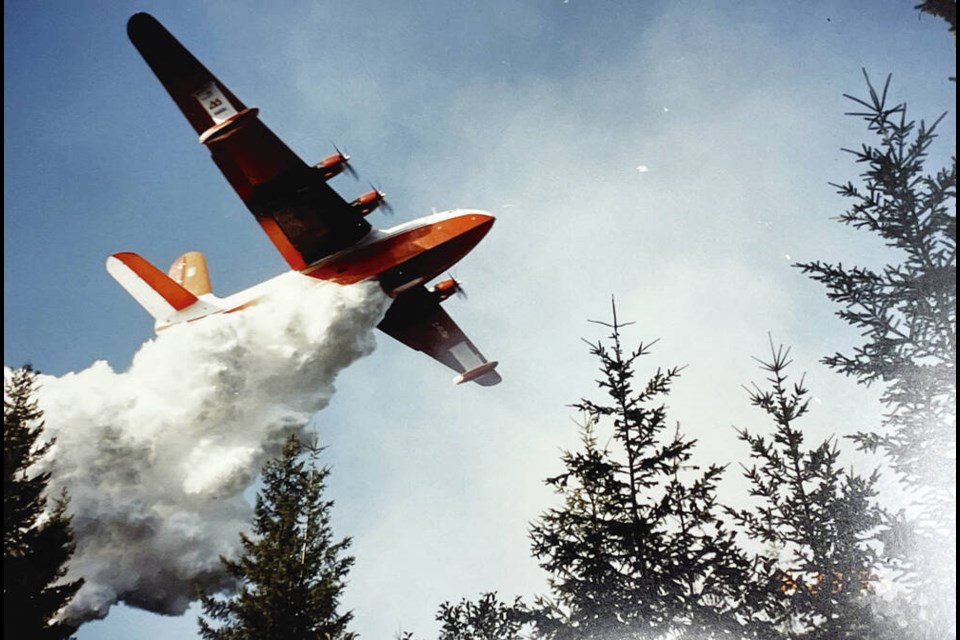Thousands are expected to watch the Hawaii Martin Mars water bomber as it makes its final flight on Sunday from Port Alberni to the B.C. Aviation Museum in North Saanich.
The water bomber is expected to leave its home base on Sproat Lake on Sunday afternoon and arrive at Patricia Bay between 6 and 6:30 p.m., depending on the weather.
Coulson Aviation, which donated the Martin Mars to the museum, isn’t announcing the exact takeoff time for safety reasons, hoping to avoid attracting crowds of boaters seeking one last look before the aircraft leaves its long-time home.
The final flight plan will include circling flyovers at several Island towns, likely Port Alberni, Campbell River, Powell River, Courtenay, Nanaimo, Duncan, Ladysmith and Crofton.
At Crofton, the Martin Mars will be joined by the Canadian Forces Snowbirds — coming from the Abbotsford Air Show — and escorted in style to its final landing at Patricia Bay.
All nine Snowbird planes will take part and are set to do a flypast over Greater Victoria.
“We expect thousands of people to watch this last flight and say goodbye to this amazing aircraft,” said Richard Mosdell, project head for the B.C. Aviation Museum.
Maj. Brent Handy, Snowbird 1 team lead, said the Snowbirds are proud to be able to fly alongside the icon of Canadian aerial forest fighting as it takes its final journey to its new home.
“The Snowbirds salute the brave firefighters, in the air and on the ground, that work to protect our country from wildfires and we are excited to see this piece of aviation history be preserved and on display to honour and inspire aviators past, present and future,” Handy said in a statement.
Fans of the 120-foot-long aircraft with a 200-foot wingspan will be able to track the Martin Mars on with its aircraft registration code CFLYL. And the roar of the plane’s massive 10,000-horsepower engines will be hard to miss.
The museum’s will also provide live flight details prior to arrival, and its will have a map of the best water viewing sites for the public to see the final landing, as well as the closed areas.
Only seven of the Martin Mars aircraft were ever made by the California-based Glenn L. Martin Company, all for the U.S. navy as ocean patrol and long-range transport during the Second World War. Most were used for naval cargo on the San Francisco-Honolulu route until 1956.
The last four, sold as scrap, were bought by a B.C. forestry consortium and later converted to water bombers. One Mars crashed while firefighting in Northwest Bay near Nanoose Bay in 1961 with the loss of four crew, and another was critically damaged in a storm.
The remaining two Martin Mars bombers were acquired by the Coulson Group in 2007 from Timberwest and its subsidiary, Forest Industrial Flying Tankers. The Philippine Mars, painted blue and white, was retired in 2012 and was recently sold to an aviation museum in Arizona.
The red and white Hawaii Mars had its last fire season in B.C. in 2015, when it secured a 30-day contract with the province.
The massive water tankers fought fires in B.C. and other provinces for more than half a century. They were the largest fixed-wing water bombers in the world, with the ability to dump about 6,000 gallons of water.
In a statement, Wayne Coulson, CEO of Coulson Aviation, said the company is proud to see the big aircraft go to the B.C. Aviation Museum.
Coulson said between 6,000 to 7,000 hours have gone into final testing of the plane, and pilots and engineers were brought out of retirement to fly it one last time.
“Our dedicated team has been working tirelessly to prepare the aircraft for this significant moment,” Coulson said. “The enthusiastic response from both the local and aviation communities has been incredible.”
Mosdell said the final flight of the Hawaii Mars has attracted international attention, with more than five million hits on the museum’s social-media account.
Museum president Steve Nichol said planning has been underway to move the Martin Mars from Patricia Bay to the museum site at the east end of Victoria International Airport.
Museum officials say they have been working closely with Nickel Brothers Moving, Nav Canada and the airport authority, First Nations, RCMP and municipal, provincial and federal governments to pull the plane out of the water and get it across West Saanich Road and onto the airport lands.
Fencing, light posts and power poles will be moved. Beaching gear, or wheels, will be attached to the plane while it’s in the water on Monday, said Nichol.
The “de-watering” process will take place on Wednesday afternoon, when the Hawaii Mars will be manoeuvered through the Patricia Bay breakwaters and slowly winched up a Canadian Coast Guard ramp onto a concrete apron.
“This moment brings the Hawaii Mars full circle as this was the original ramp and location used in 1960 to bring the aircraft on land to convert it into the era’s cutting-edge water bomber,” said Nichol.
The de-watering will involve Nickel Brothers Moving, Coulson Aviation and Cold Water Divers.
Between Aug. 19 and 23, Nickel Brothers Moving will lift the Hawaii Mars onto a heavy-haul trailer, and when airport operations have ceased for the night, move the aircraft through the airport lands.
Nichol said the move requires about four days to complete, with the aircraft being placed on a new concrete slab at its outdoor display location.
The day after the move, visitors will be able to walk around the outside of the aircraft while crews complete display preparations over several weeks, said Nichol.
The grand opening of the exhibit is set for Sept. 28. The museum is planning an “open experience format” so everyone can explore inside the aircraft and have an opportunity to sit in the pilot’s seat four storeys above the ground.




